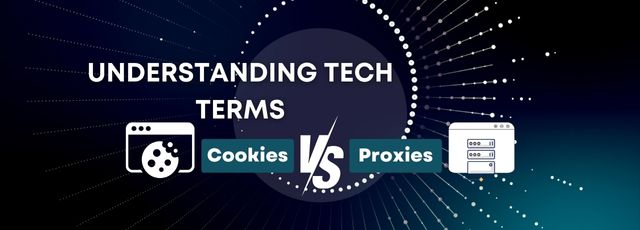The tech industry is changing rapidly, with new devices flooding the markets and cyber threats becoming more sophisticated.
Keeping up with new trends and technologies is hard enough, but the confusing and complex lingo associated with the industry doesn’t make it any easier.
If you’re among the 85% of adults who want to do more to protect their online privacy but are struggling to navigate the language, this article is for you.
We’re going to break down two common terms, cookies and proxies, to help you understand how websites track you.
What Are Cookies?
Cookies refer to text files with pieces of data that websites store every time you visit that site. This data could include preferences, login information, browsing history, and user interactions with the website.
Cookies are used for a variety of reasons, such as keeping a user logged in, personalizing a site, delivering targeted ads, and maintaining items in a shopping cart. According to a 2021 survey by Statista, nearly 32% of internet users accept cookies.
How Do Cookies Work?
Every time you visit a website, a cookie is sent to your browser and subsequently stored on your device. When you return to the site, the cookie is sent back so that the website recognizes you and can retrieve all your information.
Types of Cookies
Here are four different types of cookies:
- Session Cookies: Temporary, only stored on your device during your browsing session.
- Persistent Cookies: Remain on your device even after you close your browser.
- First-Party Cookies: Set by the website you are directly interacting with.
- Third-Party Cookies: Set by domains other than the one you’re currently visiting. According to a 2022 survey, 26% of people disabled third-party cookies in their web browsers.
What Are Proxies?
Cookies and proxies, while both common tech terms, play fundamentally different roles. Unlike cookies, proxies operate at a network level.
Proxies are like middlemen for your internet connection. They stand between your device and the vast world of the internet, and you can set them up to either block or let you access certain websites. It’s a great way to keep your online identity a secret and stay private.
How Do Proxies Work?
Think of using a proxy, like asking a friend to fetch something for you. When you want to visit a website, instead of going directly, you ask the proxy (your friend) to get the website’s info for you. The proxy then brings back what you asked for, keeping you out of the direct line of sight.
Types of Proxies
Let’s dive into some of the most common types of proxies you might come across:
- HTTP Proxies: Designed to handle web traffic.
- SOCKS Proxies: Versatile and can handle various types of traffic.
- Residential Proxies: Use IP addresses provided by internet service providers to mimic real user behavior.
- Datacenter Proxies: Offer high-speed, reliable connections.
The Key Differences
So, to review, here are the main differences between cookies and proxies:
Cookies are:
- Information is saved on your device by websites.
- Used to help websites personalize and remember preferences.
- Not intermediaries.
Proxies are:
- Intermediaries between a device and the internet.
- Provide privacy and enable bypassing geo-restrictions.
- Don’t store data.
Don’t mistake cookies or proxes for Virtual Private Networks (VPNs). VPNs are tools that encrypt connections between devices and the internet to protect sensitive data. They also hide a user’s IP address, making it so that a Canadian VPN service, for instance, could make a user appear to be in the U.S.
Although they serve different functions and operate at different levels, both cookies and proxies play a role in internet communication.
Understanding their roles can help users understand how websites track them and what actions they must take to keep data safe.
